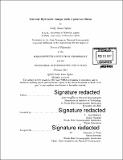| dc.contributor.advisor | Karl Helfrich. | en_US |
| dc.contributor.author | Ogden, Kelly Anne | en_US |
| dc.contributor.other | Woods Hole Oceanographic Institution. | en_US |
| dc.date.accessioned | 2017-05-12T19:00:52Z | |
| dc.date.available | 2017-05-12T19:00:52Z | |
| dc.date.copyright | 2017 | en_US |
| dc.date.issued | 2017 | en_US |
| dc.identifier.uri | http://hdl.handle.net/1721.1/109055 | |
| dc.description | Thesis: Ph. D., Joint Program in Physical Oceanography (Massachusetts Institute of Technology, Department of Earth, Atmospheric, and Planetary Sciences; and the Woods Hole Oceanographic Institution), 2017. | en_US |
| dc.description | Cataloged from PDF version of thesis. | en_US |
| dc.description | Includes bibliographical references (pages 233-237). | en_US |
| dc.description.abstract | Internal hydraulic jumps in flows with upstream shear are investigated numerically and theoretically. The role of upstream shear has not previously been thoroughly investigated, although it is important in many oceanographic flows such as exchange flows and stratified flow over topography. Several two-layer shock joining theories, characterized by their distribution of dissipation in the jump, are considered and extended to include upstream shear, entrainment, and topography. Theoretical results are also compared to 2D and some 3D numerical simulations of the full Navier-Stokes equations, which allow continuous velocity and density distributions. The solution space of idealized jumps with small upstream shear is identified using two-layer theories, which shows that upstream shear allows larger jumps to form and allows jumps for a larger range of parameters. Numerical simulations reveal several jump structures that can occur in these flows, including an undular bore, a fully turbulent jump, and a smooth front turbulent jump. At low shear, the 2D mixing efficiency is constant across simulations. As shear increases, the basic two-layer theories no longer provide solutions. Numerical simulations show that entrainment becomes significant as the shear increases, and adding entrainment and shape parameters to describe the continuous velocity profiles is required to accurately describe the simulations using two-layered theory. The entrainment depends on the upstream shear and can be predicted with a modified theory. However, use of the theory is limited due to its sensitivity to the value of the shape parameters. The 2D mixing efficiency also decreases significantly as shear increases. Finally, more realistic 2D and some 3D simulations including topography bridge the gap between the highly idealized simulations and the very realistic work of others. Simulations with topography show additional jump types, including a higher mode jump with a wedge of homogeneous, stagnant fluid similar to a structure seen in Knight Inlet. In all cases, numerical simulations are used to identify trends in the mixing and jumps structures that can occur in internal hydraulic jumps. | en_US |
| dc.description.statementofresponsibility | by Kelly Anne Ogden. | en_US |
| dc.format.extent | 237 pages | en_US |
| dc.language.iso | eng | en_US |
| dc.publisher | Massachusetts Institute of Technology | en_US |
| dc.rights | MIT theses are protected by copyright. They may be viewed, downloaded, or printed from this source but further reproduction or distribution in any format is prohibited without written permission. | en_US |
| dc.rights.uri | http://dspace.mit.edu/handle/1721.1/7582 | en_US |
| dc.subject | Joint Program in Physical Oceanography. | en_US |
| dc.subject | Earth, Atmospheric, and Planetary Sciences. | en_US |
| dc.subject | Woods Hole Oceanographic Institution. | en_US |
| dc.subject.lcsh | Hydraulics | en_US |
| dc.subject.lcsh | Ocean | en_US |
| dc.subject.lcsh | Ocean circulation | en_US |
| dc.subject.lcsh | Ocean currents | en_US |
| dc.title | Internal hydraulic jumps with upstream shear | en_US |
| dc.type | Thesis | en_US |
| dc.description.degree | Ph. D. | en_US |
| dc.contributor.department | Joint Program in Physical Oceanography | en_US |
| dc.contributor.department | Woods Hole Oceanographic Institution | en_US |
| dc.contributor.department | Massachusetts Institute of Technology. Department of Earth, Atmospheric, and Planetary Sciences | |
| dc.identifier.oclc | 986241218 | en_US |
